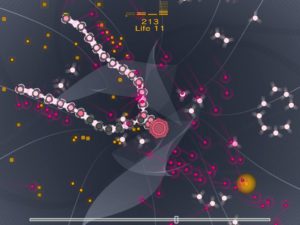I’ve asserted that music is central to Everyday Shooter, but I haven’t gone into much detail. This is because I basically lack the vocabulary. I am not learned in the ways of guitar. Nonetheless, let me give it a try.
The first song, “Robot”, is fairly relaxed, with the background music mainly consisting of simple chords repeated to a rock beat. This is the one level where nothing actively tries to kill you; things made of rectangular boxes just appear at the edges of the screen and drift across, like in Asteroids. For the most part, they take one hit to kill, and produce a simple guitar twang when you do so. There is one type of thing that fires bullets, but it doesn’t actively aim at you. It’s also important to the music, because destroying it plays a six-note motif, the only real melody that this level has. The fact that this motif can come in at any moment probably explains a lot about the background music.
Song #2, “Root of the Heart”, is based around stationary, electrically-vivid blotches that shoot various things at you (fans of bullets, ships that home in on you, slow-moving clouds, etc.) The blotches are easy to hit, but require quite a lot of shooting, the precise amount varying with their size. As a result, the player spends a lot of time just dousing them with bullets. This produces notes in very rapid descending sequence, reminiscent of Indian sitar music — which the guitar has been adjusted to imitate.
The third song, “Lush Look Killer”, is the first one that has any real structure. It alternates between two phrases, one very melodic, a sort of country thumping, the other consisting of strummed chords. There’s a large and lumpy eye in the center of the screen. During the thumping sections, truck-like boxes bring stuff to the eye that makes it grow larger if you don’t stop them. (It’s a little reminiscent of Sinistar.) During the strummed sections, the boxes disappear and tiny eyes drift around the entire screen. For the duration of this level, at least, melody corresponds to purposeful action. Strangely, I don’t recall how the player’s shots affect the music here. The effect of the two phrases seems much more significant.
“Porco in the Sky” has, as you might expect, a sky-like look, with two suns drifting about, emitting flocks of dots with triangular wings that chase you. There’s a lot of echo on the music, which starts with a longish and twangy melody, repeated twice. If you focus on destroying the suns, it takes about the length of that melody to finish off each of them. Regardless of whether you do so or not, they disappear for the next section, another bit of lazily-paced strumming, during which you’re periodically attacked by a red biplane, similar to the one in Atari 2600 Combat. (Or three such planes, if you managed to kill both of the suns.) The plane is apparently the “Porco”, presumably a reference to Miyazaki’s Porco Rosso. After its time is up, there’s a reprise of the sun melody, accompanied by another sun. Pretty much the only sound the player generates during this entire process is that of destroying the clusters of winged dots, which emit a little two-note wail like a bird’s cry.
“Build 88” is next, based around an insistent “Kathoonka-thoonka-thoonka-thoonka-thoonka-thoonka-WAH-wah” motif. The music is fast, but ironically, the enemies (various sorts of tanks and tank generators) are not. Instead, they are numerous and unstoppable, which I suppose also fits the “driving beat” idea.
I’ve managed to get to the level beyond this, “Bits of Fury”, but only once. Consequently, I don’t remember the music. I remember the gameplay, though — mainly, you have to shoot red circles to make them blow up and destroy the massive quantities of stuff that’s flying through all the time and which would otherwise kill you. I suppose this shows that I was paying more attention to the action than to the music. You really need to play through a level a few times for both to register in a way that you can remember.
 Comments(0)
Comments(0)